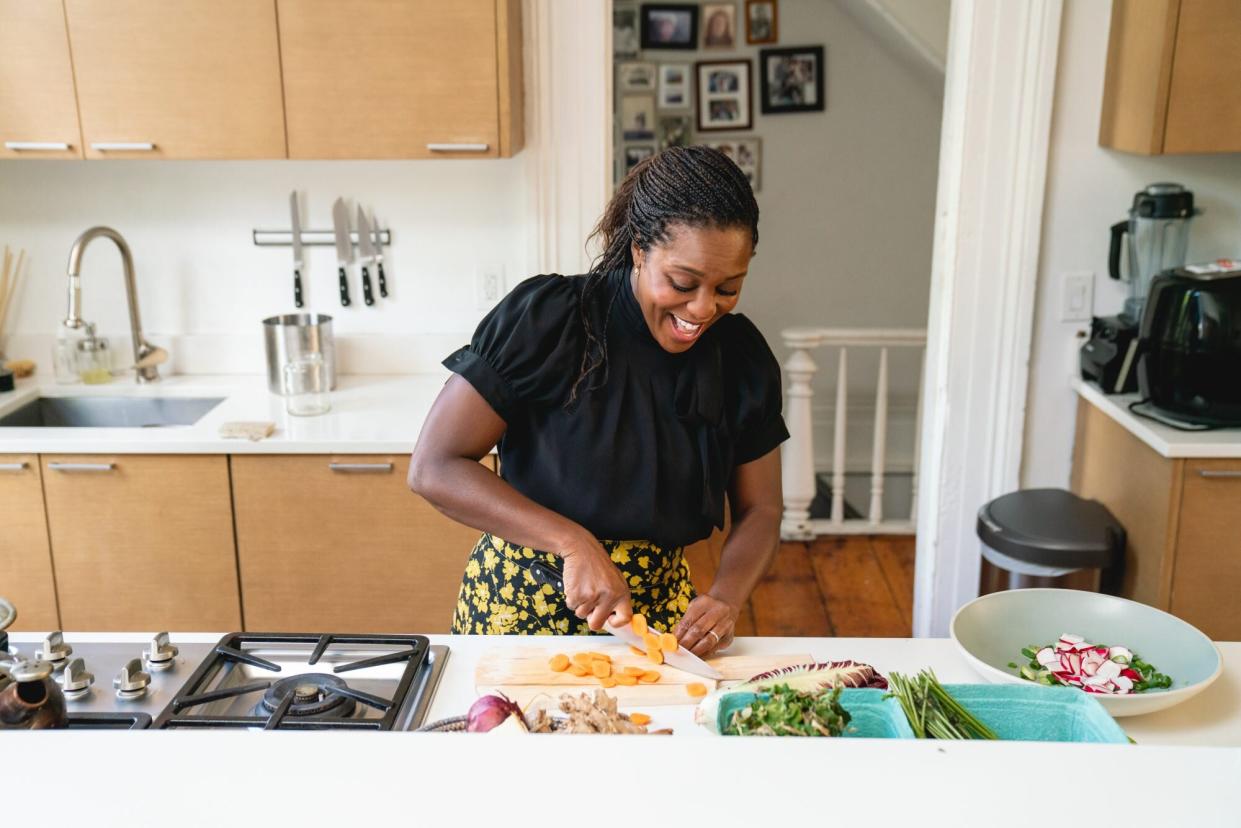This Registered Dietitian Wrote a Book About Global Cuisine, and Says There's More to Healthy Eating Than the Mediterranean Diet

Courtesy of Maya Feller / Wini Lao
There's no singular or correct way to eat or be healthy—that's one of the biggest things Maya Feller, RDN, learned while writing her new cookbook, Eating From Our Roots: 80+ Healthy Home-Cooked Favorites From Cultures Around The World. The book is a celebration of cuisine that's healthy by the merit of its origins and ingredients, rather than pure macronutrients.
This approach to nutrition is additive, not reductive, and encourages a balanced, healthy relationship with food. It's achieved by consuming a variety of foods and flavors without being absolute—after all, humans and their respective diets are not a monolith. "I want to be a part of the movement that is celebrating heritage and traditional foods from cultures around the world," Feller writes in the cookbook.
"Traditional foods have often been left out of health and culinary conversations due to colonialism, white supremacy, and structural inequities," says Feller. She is seeking to change that. She aims to use the 80 recipes sourced from around the world in her book to encourage inclusive, diverse ways to practice (and enjoy) healthy eating.
We spoke with Feller to find out what she learned while writing and recipe testing the book. The following takeaways are lessons that we can all apply to how we cook, eat, and live.
Related: Maya Feller's Weeknight Dinner Strategies
The World Is Huge—but Wellness Culture Is Limited
In her practice as a registered dietitian, Feller works with a diverse patient population. American wellness culture, however, is often centered around Anglo-American and European foodways, Feller points out. "There is so much more. The world is huge. Most often, we don't hear about all the cultural foodways," she says. "What's the culture feeding you? What are your heritage foods?"
She wanted her book to celebrate foods from around the world, shared from chefs who grew up in these traditions—and so many were willing to contribute.
Substitutions in Recipes Are Totally Fine
If you can't source an exact ingredient when make a cultural dish, swap it for something similar—and continue forward. For example, if you can't find Chinese broccoli for a recipe, use another green vegetable. "Think about the veggies and proteins available in your area and modify the recipe based on what you have," Feller says. "That's what happens when people migrate. The African diaspora used yams in Africa and then in the U.S. used sweet potatoes."
She also tells us to embrace frozen produce: "If you can't find fresh, you can use frozen—don't be afraid of frozen." Feller also provides a guide for plant-based substitutes in her book (so you can make every recipe vegan!).

Courtesy of Penguin Random House
Cooking New Cuisines Doesn't Have to Be a Challenge
Feller's recipes span from Greece to Thailand to the Caribbean and so many places in between. If cooking unfamiliar cuisines intimidates you, she has a method to ease you in. "Start with things that are more familiar," she says. "If you are a spinach person, jump into a recipe that uses spinach, and then transfer those skills to leafy greens."
In her practice, Feller speaks with patients about how to expand what they're consuming by starting with things that are familiar—they might be flavors from regions you've traveled to or even restaurants you've visited. If you've never cooked fish, start with a filet, and work your way up to a whole fish. "Take what's similar to what you know, and expand from there," she says.
Global Cuisines Are More Similar Than You Think
"As you leave the continental U.S., food becomes more similar as you move through regions," Feller says. For example, if you're traveling through the Northern Hemisphere, you'll see how neighboring regions and nations share flavors and ingredients. In her recipes, Feller tracked how Scandinavian countries share a flavor profile with foods of Western Europe—and as you get closer to the Mediterranean Sea, similar spices crop up in these cuisines. From there, dishes of North Africa are reminiscent of the Middle East.
The takeaway? As you continue to eat your way through the map, you'll find patterns. "You see flavors show up in places you may not expect," Feller says.
It's Time to Rethink the Mediterranean Diet
The Mediterranean diet is widely known as the healthiest on Earth—but outside of the 22 nations that sit on the Mediterranean Sea, this style of eating is widely misinterpreted. "When we think of the Mediterranean, we romanticize Mediterranean patterns of eating," Feller says. "We lean heavily on fish and olive oil, which are wonderful, nutrient-rich options, but there's so much more left out of that discussion. Italy is part of this region, but you never see pasta included on these lists."
Ultimately, if you're cutting out the best tastes, you're missing out—and you're not eating authentically. "Eating should be pleasurable, and that allows space for heritage foods, wherever they're from," Feller says.
You Can Stop Suffering Through Salad
If you love salad, great—enjoy! But if chomping your way through a kale Caesar is painful, put it down and find something you actually like. "I always like to remind people that they should honor their likes and dislikes when eating," Feller says. "Find a pattern of eating that works for you and centers around you as an individual. I'm excited to bring these recipes to people and expand how they define the word healthy. People can wake up and say, 'I don't have to eat a salad to be healthy.' There's no morality attached to eating salad."

